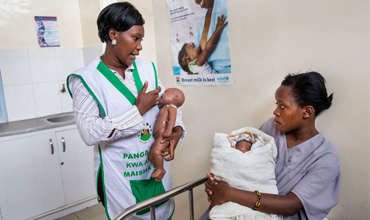Factors Affecting Utilization of Postnatal Care Services in Kenya

Abstract:
Approximately 30-40% of
direct maternal deaths in Africa are due to hemorrhage, mostly in the
postpartum period both in the hospital and in the community levels. In sub
Saharan Africa only 13 % of the mothers attend postnatal care .Adequate
utilization of postnatal care can help reduce mortality and morbidity among
mothers and their babies. This study was carried out in Province General
Hospital Nyeri, Kenya with the objective of determining the factors affecting
the utilization of postnatal services. It was a descriptive survey and
convenience sampling method was used to identify the required sample population
and a data was analyzed using descriptive statistics. A total of 240 women
successfully completed the survey. The questionnaire generated demographic
information about the mothers’ knowledge about postnatal services awareness and demographic characteristics
that were found to influence the uptake of postnatal services included age,
marital status, and parity.
Its was found that most
women lacked awareness about the services given in postnatal clinic and long
waiting time and cultural beliefs were among factors that affected utilization
of postnatal care. From the study the utilization of the postnatal services at
the hospital in 14.2% which is quite low considering the need for postnatal
services. The research recommends enhanced advocacy and communication to the
mothers on the need for use of postnatal services in the hospital.
References:
[1.] Amooti, K., & Nuwaha, F., (2000). Factors Influencing
choice of delivery sites in Rakai district of Uganda, Social science and medicine, Volume 50, 203-213.
[2.] Annet, N., (2004). Factors
influencing utilization of postnatal care services in Mulgan and Mengo
hospital, Kampala, Uganda.
[3.] Mwangangi., & Muindi., (2003). Factors
influencing utilization of maternal health in Machakos and Nairobi district.
[4.] Charlotte , P. D., Liala, T., &
Pyande, M.(2008). Postnatal care,
chapter 4, section (iii). Opportunities for Africa’s mothers and newborns,
retrieved(2013) from http:/www.prb.org/ppf07/SLN-PNCB Brief Final, pdf
[5.] Safe motherhood (2002). Safe
motherhood, a matter of human rights and social justice retrieved from
www.Safemotherhood org.htm
[6.] Central Province, Kenya.,(2010/2011).
Maternal mortality report
[7.] Estimates of Maternal mortality
Worldwide (2005). An assessment of available results. Lancet, Volume 370
[8.] Kenya National Bureau of Statistics
(KNBS) and ICF Macro 2010, Kenya Demographic and Health Survey 2008-09.
Claverton, Maryland: KNBS and ICF Macro
[9.] Maternal Child Health/FP., (2010).
Monthly report on maternal health care 10.Ministry of Health, Kenya., (2006).
Taking the Essential package of Health to the community
[10.]
Mwaniki,
P. K., (2002). Utilization of antenatal
and maternity services by mothers seeking welfare services in Mbeere District,
Eastern Province, Kenya. East African Medical Journal, Volume 79(4):184-7.
[11.]
Sathuramian
, L. N.,(2004). International Conference on Population and Development (ICPD)
London.
[12.]
Shama,
B., Utilization of Antenatal care services in Nepal. Nepal population 2004,
Volume 11, 79-97
[13.]
Sharma.,
(2007). Kathmandu declaration on reproductive health rights
[14.]
Shariff,
A. G.,(2002). Determinant of Maternal health care in India. New Delhi, India
[15.]
Stephenson,
R., & Tsui, O. A., (2002). Contextual Influences on reproductive health
services use in Uttar Pradesh, India. Studies in family planning, Volume
33(4):309-321
[16.]
United
Nations Population Fund (UNFPA)(2004). State of the World’s population 2004;
Maternal Health, Newyork.
[17.]
World
Health Organization (WHO) Maternal mortality in 2004: estimates developed by
WHO, UNICEF and UNFPA, WHO, Geneva 2004
[18.]
World
Health Organization (WHO) 2007, maternal, mortality in 2005, WHO, Geneva

